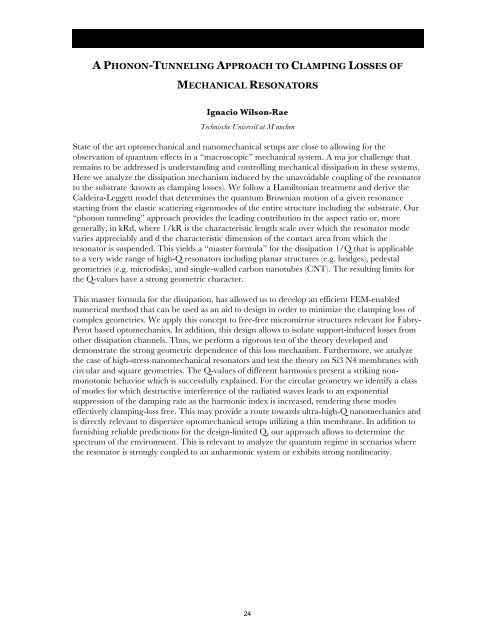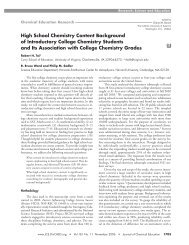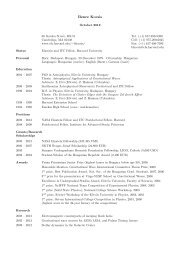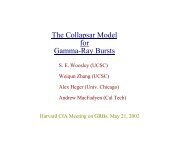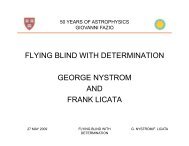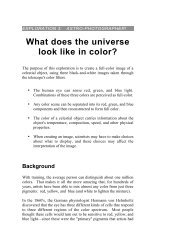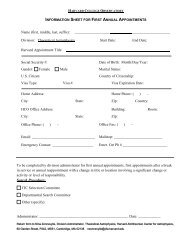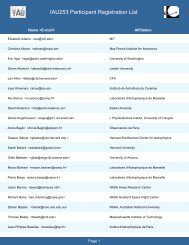Index OMC_final - Harvard University
Index OMC_final - Harvard University
Index OMC_final - Harvard University
You also want an ePaper? Increase the reach of your titles
YUMPU automatically turns print PDFs into web optimized ePapers that Google loves.
A PHONON-TUNNELING APPROACH TO CLAMPING LOSSES OF<br />
MECHANICAL RESONATORS<br />
Ignacio Wilson-Rae<br />
Technische Universit ̈at M ̈unchen<br />
State of the art optomechanical and nanomechanical setups are close to allowing for the<br />
observation of quantum effects in a “macroscopic” mechanical system. A ma jor challenge that<br />
remains to be addressed is understanding and controlling mechanical dissipation in these systems.<br />
Here we analyze the dissipation mechanism induced by the unavoidable coupling of the resonator<br />
to the substrate (known as clamping losses). We follow a Hamiltonian treatment and derive the<br />
Caldeira-Leggett model that determines the quantum Brownian motion of a given resonance<br />
starting from the elastic scattering eigenmodes of the entire structure including the substrate. Our<br />
“phonon tunneling” approach provides the leading contribution in the aspect ratio or, more<br />
generally, in kRd, where 1/kR is the characteristic length scale over which the resonator mode<br />
varies appreciably and d the characteristic dimension of the contact area from which the<br />
resonator is suspended. This yields a “master formula” for the dissipation 1/Q that is applicable<br />
to a very wide range of high-Q resonators including planar structures (e.g. bridges), pedestal<br />
geometries (e.g. microdisks), and single-walled carbon nanotubes (CNT). The resulting limits for<br />
the Q-values have a strong geometric character.<br />
This master formula for the dissipation, has allowed us to develop an efficient FEM-enabled<br />
numerical method that can be used as an aid to design in order to minimize the clamping loss of<br />
complex geometries. We apply this concept to free-free micromirror structures relevant for Fabry-<br />
Perot based optomechanics. In addition, this design allows to isolate support-induced losses from<br />
other dissipation channels. Thus, we perform a rigorous test of the theory developed and<br />
demonstrate the strong geometric dependence of this loss mechanism. Furthermore, we analyze<br />
the case of high-stress nanomechanical resonators and test the theory on Si3 N4 membranes with<br />
circular and square geometries. The Q-values of different harmonics present a striking nonmonotonic<br />
behavior which is successfully explained. For the circular geometry we identify a class<br />
of modes for which destructive interference of the radiated waves leads to an exponential<br />
suppression of the damping rate as the harmonic index is increased, rendering these modes<br />
effectively clamping-loss free. This may provide a route towards ultra-high-Q nanomechanics and<br />
is directly relevant to dispersive optomechanical setups utilizing a thin membrane. In addition to<br />
furnishing reliable predictions for the design-limited Q, our approach allows to determine the<br />
spectrum of the environment. This is relevant to analyze the quantum regime in scenarios where<br />
the resonator is strongly coupled to an anharmonic system or exhibits strong nonlinearity.<br />
24


